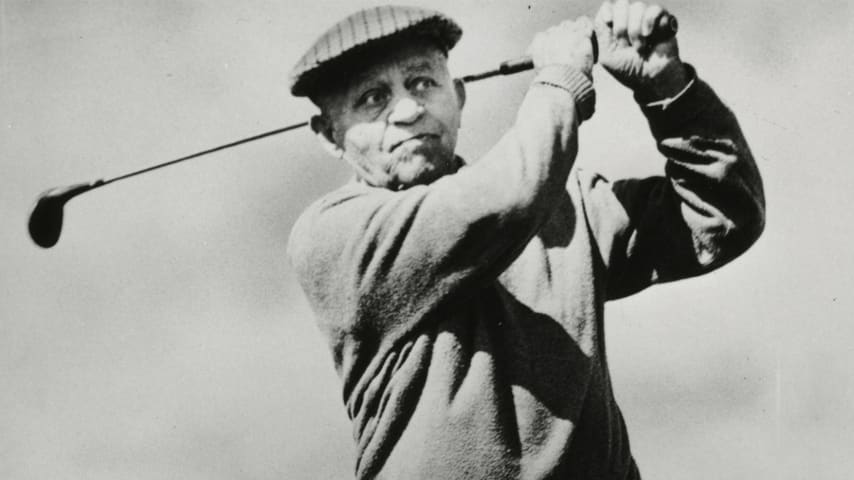Remembering John Shippen
5 Min Read

The namesake for the John Shippen Invitational was one of golf’s groundbreakers
Written by Birches Health
The namesake for the John Shippen Invitational was one of golf’s groundbreakers
Editor’s Note: The following story is republished with permission from the John Shippen Invitational, which aims to create opportunities in golf for Black men and women, ensure Shippen’s story is told and preserve his tremendous legacy. The Shippen, which invites the nation’s top Black amateur and professional golfers, is being played June 27-28 at Detroit Golf Club. The men’s winner will earn a spot in the PGA TOUR’s Rocket Mortgage Classic. Click here to learn more about the John Shippen Invitational.
John Matthew Shippen Jr. (1879-1968) was born on December 5, 1879. His father, born into slavery in Virginia, became a free man following the Civil War. He then moved to Washington, D.C., where he attended Howard University and received a degree in theology. When John Jr. was 9 years old, his family moved to the Shinnecock Indian Reservation in Southampton on Long Island, New York, where his father was assigned as pastor.
As a teenager, Shippen worked with crews to help clear the land and build the original Shinnecock Hills Golf Club, which was near the reservation. Willie Dunn, a Scottish golf professional who designed the final holes at Shinnecock Hills, taught some of the young workers how to caddie and play the game, including John Shippen and his friend, Oscar Bunn, a Shinnecock Indian. Shippen had a natural talent for the game and became one of Dunn’s best students. By the age of 16, Shippen was working full-time as Dunn’s assistant, giving lessons to members, working as a caddy, repairing clubs, scorekeeping and assisting the maintenance crew.
Shinnecock Hills was selected to host the second U.S. Open in 1896. Club members (said to include the Rothchilds, the Mellons and the Carnegies) were so impressed with Shippen’s talent that they paid his and Bunn’s entry fees for the tournament. The week of the Open, other professional entrants (all foreign-born) sent a petition to USGA officials in which they objected to “colored boys meeting them on equal terms.” They held a meeting in protest on Thursday prior to the Open and threatened to withdraw if Shippen and Bunn were allowed to compete. USGA president Theodore Havemeyer is said to have declared, with conviction: “Gentlemen, you can leave or stay as you please. We are going to play this tournament tomorrow, with them – and with or without you.” All entrants showed up the next morning for play.
Shippen was tied for the lead after shooting 78 in the first round. In the second round, his tee shot on the par-4 13th hole landed in a sandy road, which led to an 11 on the hole. He finished the second round with an 81 for an overall score of 159 for the 36-hole tournament. The seven strokes he lost on the 13th hole was the difference between his final score and the winning 152 by James Foulis of Scotland.
In Pete McDaniel’s Uneven Lies: The Heroic Story on African-Americans in Golf, Shippen is quoted as describing the 13th Hole as: “a little, easy par-4. I’d played it many times and I knew I had to stay on the right side of the fairway with my drive. Well, I played it too far to the right and the ball landed in a sand trap road. Bad trouble in those days before sand wedges. I kept hitting the ball along the road, unable to lift it out of the sand and wound up with an unbelievable 11 for the hole. You know, I’ve wished a hundred times I could have played that little par-4 again.”
Shippen finished the tournament in 5th place and Bunn finished 21st. Shippen was awarded $10 in prize money, which officially secured his place in history as the first U.S.-born golf professional and the first Black golf professional.
At the time, a leading sporting magazine was said to claim that Shippen should be “given every opportunity to show what he can do.” Although historical records differ, Shippen is known to have played in several U.S. Opens, including 1896 (T5), 1899 (T25), 1900 (T27), 1902 (T5) and 1913 (T41). No other Black golfer would play in the U.S. Open again until Ted Rhodes in 1948.
Shippen’s family returned to D.C., but he decided to remain in Shinnecock on his own. He was hired as the golf professional at the Maidstone Club in East Hampton, New York. He went on to work as the golf pro at several clubs including Aronimink Golf Club near Philadelphia, Pennsylvania, but he is best known for his tenure as the head pro at the Shady Rest Golf Course (now known as Scotch Hills Country Club) in Scotch Plains, New Jersey. Shady Rest was the first Black golf club in the United States – which was established to provide recreation and entertainment for all ages. Activities included golf, tennis, horseback riding, skeet shooting concerts, dining, etc.
Shippen worked at the Shady Rest from 1924 until his retirement in 1960 during an era when Black luminaries, scholars, social reformers and entertainers such as W.E.B. DeBois, Count Basie, Ella Fitzgerald, Duke Ellington, Billie Holliday and Cab Calloway came to perform and enjoy themselves, and where Althea Gibson honed her tennis skills.
In 2009, the PGA of America posthumously bestowed John Shippen with his PGA membership card. He is now recognized by the USGA as America’s first golf professional. In 2018, he was inducted into the New Jersey Golf Association Hall of Fame’s Inaugural Class.
History has largely omitted John Shippen’s story, which has left several outlets to begin filling in the blanks that have been left undocumented. Even his ancestry has been confused over the years, with some claiming he was a descendant of the Shinnecock tribe. In John H. Kennedy’s book, A Course of Their Own: A History of African-American Golfers, Shippen’s daughter, Clara Johnson, reiterated that both of her father’s parents were Black, saying: “My father was a Negro. Every time I meet somebody, I have to correct that story.”
John Shippen’s participation and prowess paved the way for all American golfers today who stand on his shoulders. The John Shippen Invitational aims to create opportunities in golf for Black men and women, ensure his story is told and preserve his tremendous legacy, which is one of Black History, but also of American History.





